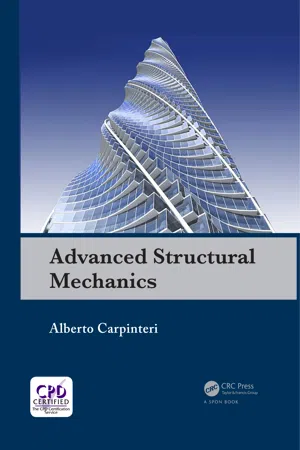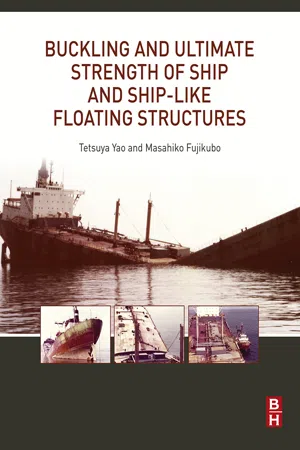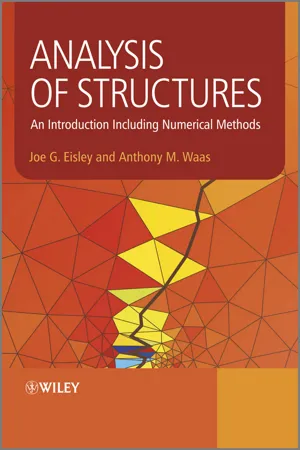Euler Buckling Formula
The Euler buckling formula is a mathematical equation used to predict the critical buckling load of a slender column under compressive axial loads. It takes into account the column's material properties, length, and moment of inertia. The formula provides a valuable tool for engineers to assess the stability of structural elements and prevent buckling failure.
8 Key excerpts on "Euler Buckling Formula"
- eBook - ePub
Introduction to Engineering Mechanics
A Continuum Approach, Second Edition
- Jenn Stroud Rossmann, Clive L. Dym, Lori Bassman(Authors)
- 2015(Publication Date)
- CRC Press(Publisher)
...11 Instability: Column Buckling In our analysis of the internal response to external loading on bars, beams, pressure vessels, and shafts in torsion, we have had two primary concerns: the stiffness and the strength of the structure. By strength, we mean the ability of our structure to support the required loads without experiencing excessive stress; by stiffness, we mean its ability to support the required loads without undergoing excessive deformations. In practice, we have a third concern: the stability of our structure, by which we mean its ability to support the required loads without experiencing a sudden change in configuration. The instability known as buckling typically occurs when forces much lower than those necessary to exceed material yield stresses are applied. Buckling can occur whenever a slender * structural member is subjected to compression. These forces are applied axially, as shown in Figure 11.1. Here, by holding a metal ruler between his palms, a man has been able to induce instability, and the ruler fails as a structural element. The most common occurrence of this kind of loading, and of buckling instability, is in columns. Figure 11.2 shows some examples of structural columns: the ancient Greek Parthenon contained columns that were constructed of stacked stones, not single slender supports; the nineteenth-century use of iron as a structural material led to slender metal compressive members such as those on the Welsh viaduct shown, and these members are susceptible to buckling, as are the concrete columns of Markle Hall. Figure 11.3 shows failed columns. 11.1 Euler’s Formula Consider a column of length L supported by pin supports at both ends, subjected to a compressive axial load P that acts through the centroid of the cross section, as in Figure 11.4a. We would like to determine the critical value, P cr, for which the initial position is no longer stable...
- eBook - ePub
Stability of Structures
Principles and Applications
- Chai H Yoo, Sung Lee(Authors)
- 2011(Publication Date)
- Butterworth-Heinemann(Publisher)
...Chapter 1. Buckling of Columns Contents 1.1. Introduction 1 1.2. Neutral Equilibrium 3 1.3. Euler Load 4 1.4. Differential Equations of Beam-Columns 8 1.5. Effects of Boundary Conditions on the Column Strength 15 1.6. Introduction to Calculus of Variations 18 1.7. Derivation of Beam-Column GDE Using Finite Strain 24 1.8. Galerkin Method 27 1.9. Continuous Beam-Columns Resting on Elastic Supports 29 1.9.1. One Span 29 1.9.2. Two Span 31 1.9.3. Three Span 32 1.9.4. Four Span 34 1.10. Elastic Buckling of Columns Subjected to Distributed Axial Loads 39 1.11. Large Deflection Theory (The Elastica) 45 1.12. Eccentrically Loaded Columns—Secant Formula 54 1.13. Inelastic Buckling of Straight Column 57 1.13.1. Double-Modulus (Reduced Modulus) Theory 58 1.13.2. Tangent-Modulus Theory 62 1.14. Metric System of Units 69 General References 69 References 71 Problems 73 1.1. Introduction A physical phenomenon of a reasonably straight, slender member (or body) bending laterally (usually abruptly) from its longitudinal position due to compression is referred to as buckling. The term buckling is used by engineers as well as laypeople without thinking too deeply. A careful examination reveals that there are two kinds of buckling: (1) bifurcation-type buckling; and (2) deflection-amplification-type buckling. In fact, most, if not all, buckling phenomena in the real-life situation are the deflection-amplification type. A bifurcation-type buckling is a purely conceptual one that occurs in a perfectly straight (geometry) homogeneous (material) member subjected to a compressive loading of which the resultant must pass though the centroidal axis of the member (concentric loading). It is highly unlikely that any ordinary column will meet these three conditions perfectly. Hence, it is highly unlikely that anyone has ever witnessed a bifurcation-type buckling phenomenon...
- eBook - ePub
- Theodore V. Galambos(Author)
- 2016(Publication Date)
- Dover Publications(Publisher)
...Asymmetric shapes will buckle in a mode involving twisting and deflection in one or both of the principal directions, depending on whether the cross section has one axis of symmetry or none. 4.3. ELASTIC BUCKLING OF FRAMES In the analysis of the strength of plane frames (see Chapter 6) it is necessary to know the elastic buckling load of the frame in the plane of the frame. The knowledge of this load in itself is not enough to assess the strength of the frame, but it is one important factor which must be considered, as we shall see in Chapter 6. The sketch in Fig. 4.11 shows a simple frame with axial loads acting on the column tops. If P is less than a critical value, then the frame is undeformed except for the shortening of the columns. When P = P cr, a buckled shape is possible (dashed lines in Fig. 4.11). We are interested in the value of this critical load. It can be obtained in the same manner by which we found the critical load of the structure in Fig. 4.3, that is, by substituting the boundary conditions into the deflection equation and setting the resulting buckling determinant equal to zero. For frames with many members such a procedure is, however, too complex, and an approximate procedure must be found. We shall derive one possible approximate procedure after the introduction of the slope-deflection equation method of solving frame-buckling problems. Fig. 4.11. Side-sway buckling of a rigid frame SLOPE-DEFLECTION EQUATIONS The slope-deflection equations of classical indeterminate structural analysis (3.24) relate the end rotations θ A and θ B and the bar rotation ρ to the end moments M A and M B [ Fig. 4.12(d) ]. For a prismatic bar these equations are equal to (3.24) Equations (4.67) are valid only if P = 0. In the presence of P we need new equations, and these are derived as follows: The differential equation governing the deformations of the beam-column in Fig. 4.12(a) is [from Eq...
- eBook - ePub
- Alberto Carpinteri(Author)
- 2017(Publication Date)
- CRC Press(Publisher)
...Chapter 7 Buckling instability in slender, thin, and shallow structures 7.1 INTRODUCTION The hypothesis of small displacements so far advanced considers the cardinal equations of statics in relation to undeformed structural configurations. In other words, the elastic displacements have been hypothesized as being so small as to make it possible for the deformed configuration to be confused with the undeformed one when the static characteristics are to be evaluated. In this chapter, this hypothesis will be removed, and it will be shown how the solution of an elastic problem can represent, in actual fact, a condition of stable, neutral, or unstable equilibrium, according to the magnitude of the load applied. Moreover, there exist, around the condition of neutral equilibrium, an infinite number of other similar conditions, characterized by different static parameters (applied loads) and kinematic parameters (configuration of the system). The instability of elastic equilibrium occurs in general for slender or thin structural elements subjected to compressive loads, such as columns of buildings, machine shafts, struts of trusses, thin arches and shells, and cylindrical and spherical shells subjected to external pressure. But, also, other cases that are more complex as regards both their geometry and the loading conditions can equally be considered. It will suffice to think of the lateral torsional buckling of beams of thin rectangular cross section, where the disparity between the orders of magnitude of the two central moments of inertia can cause, in a deflected beam, a sudden torsional deformation. The instability of elastic equilibrium is, moreover, a critical phenomenon that may affect an entire beam system before it involves a particular element of the system. This occurs in the case of metal trussed or framed structures, which are frequently made up of extremely slender rods or beams. The loss of stability of elastic equilibrium is commonly referred to as buckling...
- eBook - ePub
- C. T. Sun, Ashfaq Adnan(Authors)
- 2021(Publication Date)
- Wiley(Publisher)
...8 Elastic Buckling 8.1 INTRODUCTION Failure in a structure can be classified in two general categories, material failure and structural failure. The former includes plastic yielding, rupture, fatigue, and unstable crack growth (fracture). In the latter category, examples include flutter (excessive dynamic deflection of a structure in airflow) and buckling. Structural failure results in the loss of the designed structural functions and may lead to eventual material failure. In this chapter, we study an important mode of structural failure – buckling. For the sake of brevity, the transverse displacements of the bar are denoted by w and v instead of the w 0 and v 0 used in Chapter 4. 8.2 ECCENTRICALLY LOADED BEAM‐COLUMN A bar is called a beam‐column if it is subjected to bending moments and compressive axial forces. An example is the cantilever bar subjected to an eccentrical load as shown in Figure 8.1. The vertical arm attached to the free end is assumed to be rigid. Referring to the deformed configuration shown in Figure 8.1, the bending moment at section x is where w (x) is the transverse deflection of the bar and δ is the deflection at the free end. Using the bending Eq. (4.14), we have which can be expressed as (8.1) where (8.2) The general solution for the nonhomogeneous linear ordinary differential Eq. (8.1) is easily obtained as (8.3) Fig. 8.1 Cantilever bar subjected to an eccentric load. The three unknowns C 1, C 2, and δ are determined using the boundary conditions, i.e. (8.4) (8.5) and (8.6) Solving the three equations above, we obtain (8.7) (8.8) with which we have the deflection as (8.9) From Eq. (8.8) we see that the tip deflection δ is proportional to the eccentricity e, and that δ → ∞ as kL → π /2 no matter how small e (≠0) is. The compressive force corresponding to kL = π /2 is (8.10) At this load, a straight bar under axial compression would suffer excessive deflection (or buckling). This critical load as given by Eq...
- Tetsuya Yao, Masahiko Fujikubo(Authors)
- 2016(Publication Date)
- Butterworth-Heinemann(Publisher)
...(3.14). In the analytical method, the buckling deflection is approximated by an analytical function that satisfies the boundary conditions for buckling deflection. For example, for a rectangular plate of the length a and width b, simply supported along its four sides, that is, the deflection is constrained while rotation about the side is free, the following double trigonometric series can be used as a general form of buckling deflection. w = ∑ i = 1 m ∑ j = 1 n A i j sin i π x a sin j π y b (3.15) Substituting this deflection function into Eq. (3.14), the following expression is obtained: ∂ ∂ A i j (U e + U p − T) δ A i j = 0 (3.16) Since U e, U p, and T are the quadratic functions of the deflection amplitudes A ij, Eq. (3.16) results in linear simultaneous equations with respect to A ij of which number is (m × n). From the condition that Eq. (3.16) holds regardless of δA ij, the following equation is derived: ([ G 1 ] − λ [ G 2 ] − [ G 3 ]) { A i j } = 0 (3.17) where the matrix [ G 1 ] is obtained from Eqs. (3.10), (3.11), and [ G 2 ] and [ G 3 ] from Eq. (3.12). [ G 2 ] is a function of the stress components, σ x, σ y, and τ xy, for λ = 1 and [ G 3 ] is that of the residual stress components, σ xr, σ yr, and τ xyr. For the occurrence of buckling, nonzero { A ij }s have to appear as the solutions of coefficient matrix in Eq. (3.17). This corresponds to the condition that the determinant of Eq. (3.17) has to be zero, that is ∣ [ G 1 + G 3 ] − λ c r [ G 2 ] ∣ = 0 (3.18) λ cr that satisfies Eq. (3.18) gives the buckling load. 3.2.2 Elastic Buckling Strength of a Rectangular Plate Under Uni-Axial Thrust Here, a simple example of a rectangular plate under uni-axial compression is considered as shown in Fig. 3.8, where welding residual stress and buckling mode are illustrated...
- eBook - ePub
Analysis of Structures
An Introduction Including Numerical Methods
- Joe G. Eisley, Antony M. Waas(Authors)
- 2011(Publication Date)
- Wiley(Publisher)
...Of special interest is the case where the lateral load, f y (x), is zero and the axial load is compressive. Such a structure is commonly called a column. We consider this in the next section. 14.3 Buckling of a Column Consider the case of a uniform beam with no lateral load but a constant axial compressive load that produces a constant internal force N =− P. Equation 14.2.22 becomes (14.3.1) For convenience let (14.3.2) then (14.3.3) This equation has a very interesting solution. Either v (x)=0 or λ takes on a series of discrete non zero values for which a solution other than v (x) = 0 is possible. In the study of differential equations this is called an eigenvalue equation. The discrete values of λ imply discrete values of P. The lowest non zero value of P is called the buckling load. Furthermore for each discrete value of λ there is a non zero solution for v (x) which is called the eigenvector or mode shape. We shall now develop this solution. Ordinary differential equations with constant coefficients have solutions of the form (14.3.4) If we substitute this into Equation 14.3.3 we get (14.3.5) This equation has four roots as follows (14.3.6) where. The solution to Equation 14.3.3 is (14.3.7) or since this may be rewritten as (14.3.8) The values of these constants of integration are obtained from the boundary conditions. For a typical column with two boundary conditions at each end the result is a set of four homogeneous algebraic equations containing the four constants of integration. These can be written in matrix form where the coefficients of the constants of integrations are just shown as a 4 × 4 matrix. (14.3.9) One possible solution is that (14.3.10) but this means there is no lateral displacement. It so happens that there is another possibility under certain circumstances...
- eBook - ePub
- N. S. Trahair(Author)
- 2017(Publication Date)
- CRC Press(Publisher)
...The choice of suitable buckled shapes is considered in section 3.3, five examples are worked in section 3.4, and methods of increasing the accuracy are given in section 3.5. 3.2 The energy method 3.2.1 BUCKLING AND CONSERVATION OF ENERGY The condition of neutral equilibrium at bifurcation buckling follows from the principle of conservation of energy (section 2.5). As the structure under a fixed set of loads buckles from an unbuckled position in a quasi-static manner to an adjacent buckled position which is one of equilibrium, the increase in the strain energy 1 2 δ 2 U stored in the structure is matched by an equal decrease in the potential energy – − 1 2 δ 2 V of the loads. Thus the energy equation at buckling can be expressed as 1 2 (δ 2 U + δ 2 V) = 0. (3.1) For the flexural-torsional buckling of a column (section 2.8.3) these changes are given. by 1 2 δ 2 U = 1 2 ∫ 0 L { E I y u ″ 2 + E I x v ″ 2 + E I w ϕ ″ 2 + G J ϕ ′ 2 } d z, 1 2 δ 2 V = − 1 2 ∫ 0 L P { u ′ 2 + v ′ 2 + (I P / A + x 0 2 + y 0 2) ϕ ′ 2 −[--=PLGO-SEP. ARATOR=--]2 x 0 v ′ ϕ ′ + 2 y 0 u ′ ϕ ′ } d z } (3.2) and. by 1 2 δ 2 U = 1 2 ∫ 0 L { E I y u ″ 2 + E I w ϕ ″ 2 + G J ϕ ′ 2 } d z, 1 2 δ 2 V = − 1 2 ∫ 0 L P { u ′ 2 + (I P / A + y 0 2) ϕ ′ 2 + 2 y 0 u ′ ϕ ′ } d z + 1 2 ∫ 0[--=PLGO-SEP. ARATOR=--]L M x { 2 ϕ u ″ + (I P x / I x − 2 y 0) ϕ ′ 2 } d z } (3.3) for monosymmetric beam-columns with transverse loads at the shear centre (section 2.8.5), in which u, v, ϕ are the buckling deflections and twist rotation, and P is positive for members in compression. The strain energy changes 1 2 δ 2 U in these equations include the strain energy changes due to bending about both or one of the x, y principal axes, and to warping and uniform torsion caused by the twist rotations ϕ...







